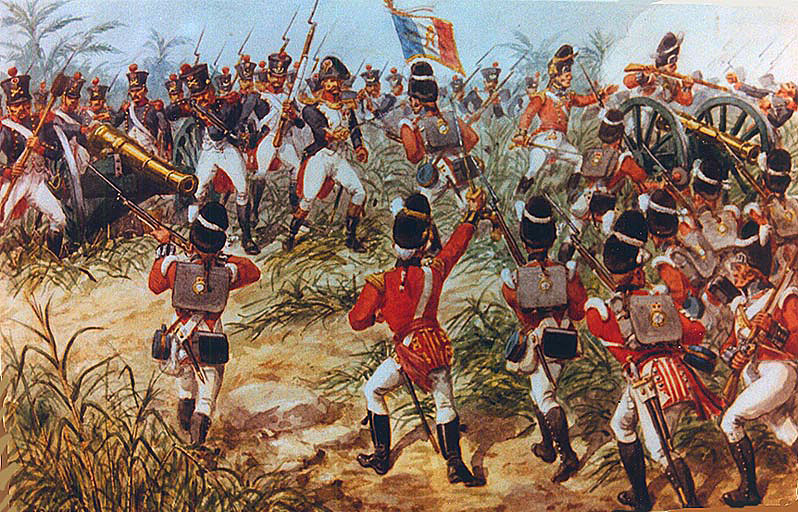The Second Battalion in the Peninsula
In the same way that the 66th had been created from the Second Battalion of HM 19th Foot for service in the Seven Years War; in 1802, at the outbreak of the Napoleonic Wars, the 66th raised its own Second Battalion for service abroad and in 1809 it was ordered to Spain.
The Crossing of the Douro
The Second Battalion’s first engagement with the enemy came on the 13th May 1809.
Wellington was moving his forces from the coast towards the Spanish frontier but first he had to dislodge the French from Northern Portugal. Soult’s occupation of Oporto stood in the way. However, the city was on the east bank of the River Douro and to reach the city, Wellington had to cross the obstacle of the river from the west.
British forces reached the west bank on the evening of the 11th and camped out in the streets for the night. Meanwhile, the French blew up the bridge leaving the British with no way across.
However, during the night a man – believed to be a barber – had rowed across from the opposite side of the river and reported that there were three empty wine barges moored on that side that could not be seen from the city due to a bend in the river. These could be used to transport troops across the river if they could be brought over.
Colonel Waters of the Staff set off with the man back across the Douro and the three barges were safely brought over by a small party. At 10am on the 12th, Wellington gave the order to make the crossing and the first troops of the HM 3rd Foot (The Buffs) set off. Their landing was unopposed and they set up a defensive position in a seminary on the other side. Further companies of the 3rd, 48th and 66th crossed next and the seminary was secured.
By this coup de main the lower part of the town was taken from the French after sharp fighting with the 66th losing 35 men and 3 officers.
Wellington congratulated the troops in a general order issued in the following day:
The commander of the forces congratulates the troops upon the success that has attended the operations of the last four days; during which they have traversed above 50 miles of the most difficult country, have carried some formidable positions, have beaten the enemy repeatedly and have ended by forcing the passage of the Douro….The commander of the forces has had repeated opportunities of witnessing and applauding the gallantry of the officers and men.”
The Second Battalion received its first battle honour: Douro
Talavera
On the 28th July 1809, the Second Battalion fought its second action.
The town of Talavera lay at a key crossing on the River Tagus. From the town flowing north-south flowed the Portina brook which was ankle deep and would not stop the French. To the north of the town there was a wide plain that was bounded by a range of mountains. The main feature of the three mile wide plain was two hills one on each side of the brook. The British would occupy the west bank of the brook and fortify the Medellin hill and the French would occupy a similar feature on the other side of the brook, the Cascajal hill.

As darkness fell, the troops settled down for an uneasy night as they listened to the sound of the French troops doing likewise opposite their positions. Little sleep could be expected in anticipation of the battle that would follow the next morning.
A dramatic event in which the 66th were involved now took place. At 10pm firing broke out at the bottom of the Medellin and Wellington could see muzzle flashes from where he was standing further south. At first, Daddy Hill, commanding the Division, standing with his staff on top of the hill, blamed the 3rd ‘the old Buffs as usual making some blunder’. The British outposts challenged the shadowy figures of troops marching up the hill towards them and a hoarse voice replied in a German that they were from the King’s German Legion. However, it soon became apparent that this was a trick and the 2nd Division was facing a full night-time assault carried out by no less than two French infantry divisions. French Marshal Victor had also worked out that the possession of the Medellin hill was the key to the battle.
The troops of the 29th and 66th moved down from the summit where they had been placed and, forming into line, opened fire in the darkness on the approaching French with musket volleys at under 40 yards. Fierce hand-to-hand combat quickly followed with the troops using their muskets-butts and bayonets to drive the enemy back down the hill. By now, Wellington had reached the Medellin to supervise the defence and, when the French had gone, wrapped himself in a blanket before lying down on the ground to snatch some sleep.
Very early on the morning of the 28th July, the French opened fire with long range cannon on the Medellin but Wellington had ordered the troops to move back beyond the crest and British casualties were light. Meanwhile, at daybreak a French column of 4,300 men crossed the Portina brook and moved towards the British line. After a violent struggle, the French infantry broke, retreating back across the brook and both sides met to recover their dead and wounded as was the custom.
The 66th had been heavily involved the whole day and the battalion suffered casualties of 16 officers and 83 men killed or wounded.
The Regiment received its second battle honour of the war: Talavera. No doubt their behaviour on the Medellin had been witnessed by Wellington personally.

